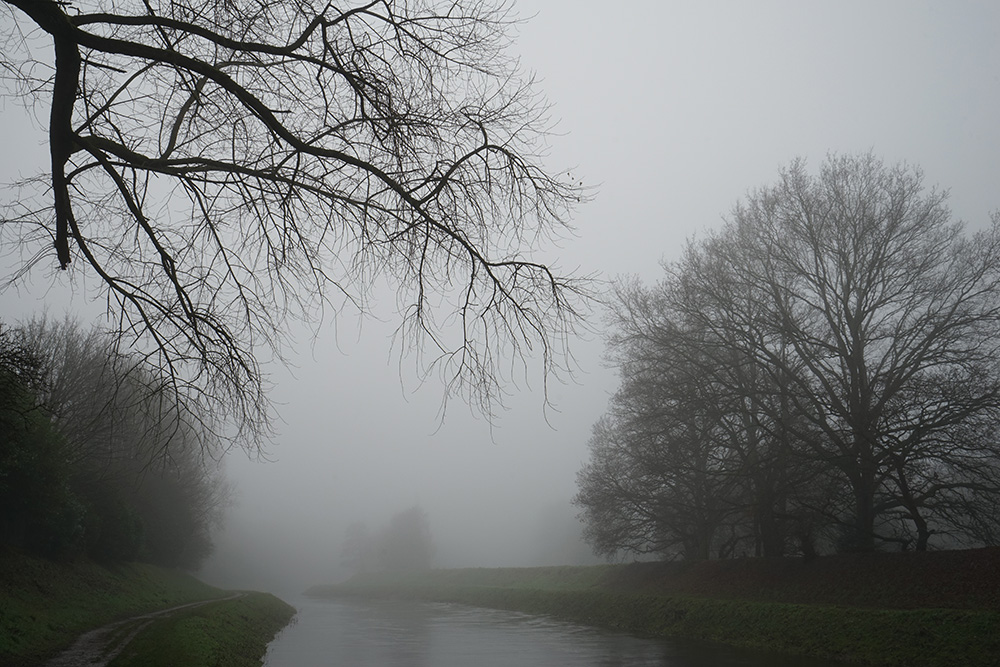There is something about winter
which pares all living things down to their essentials
– Moya Cannon, Winter Paths
There’s quite good local walking where I live. River, woods, lake and nature reserves within reach. Kestrels occasionally, kingfishers rarely but memorably, perhaps once a year. There are owls in the woods. In the pandemic lockdown I walked then sat in my car to read. In winter darkness, seven fifteen, there it was. Owl song I like to say, not a hoot.
I know the places well. The first digital camera I acquired was a Canon 10D and I experimented on a local path, thrilled with the immediate image on a screen. A winter view, with winter colours, muted green and grey. I thought this will be fun in spring and summer. I don’t remember my first big digital walk. It might have been at Borrowdale in the Lake District. But I liked the winter views, and didn’t dismiss them.
Winter has a particular beauty, with the limited colours under blank grey skies. Mist and fog photographs extend the idea. Even more minimalist, less radiance, with quietness the idea of the scene. It’s my favourite weather for urban nature. In the mountains, a photograph is changed by weather but not created by it entirely. Modest places need it more, mist and fog a good example.
When I started photography as a boy, I walked local streets. Views of the library roof, park bench, a wooden fence in the snow. One of the exercises was an assignment called Figure and Letter Forms. I went to Greenwich Park with my Dad and asked him to stand, making a shadow, on the numeral depth markers of the Cutty Sark. I got a Grade A for photography and remember it as a formative time for understanding the practice, although there was very little teaching. Composition for example, I worked out myself.
There’s a photographic idea where people say you can find a good photograph anywhere. It’s partly true, but partly nonsense, if you compare the Scottish Highlands with a field. I knew local streets were limiting my early photography which is why I went to Greenwich, and for beach huts on the Kent coast. A few years later, I travelled to Leicester Square in London for people. I still have those photographs. A tourist being sketched by an artist, multiple gazes one of which was drawn. I found that curious.
It is fun however, finding interest in modest places. It exercises you artistically, when there isn’t obvious appeal. The same applies comparing the Peak District to Scotland or Snowdonia. Lovely area as it is, the hills are small not soaring. The Peak District skies are more of an attraction, shadows on the hills as much as summit views. I like photographing the Peak District because of photogenic difference.
There’s a Japanese style of art called Ukiyoe-e which means ‘pictures of the floating world.’ In Kazuo Ishiguro’s novel Artist of the Floating World he says:
I suspect the reason I couldn’t celebrate the floating world was that I couldn’t bring myself to believe in its worth…I suppose I thought that to pass away one’s time in such places, to spend one’s skills celebrating things so intangible and transient, I suppose I thought it all rather wasteful, all rather decadent. It’s hard to appreciate the beauty of a world when one doubts its very validity.
This is partly referring to night time entertainment in an area of the city he calls the “pleasure district.” Partly too he’s describing the aesthetic of a dreamy other world. Fog and mist express the idea. Intangible, transient, when the sun arrives it’s gone. In the mountains, fog means limited navigation. In the city, something else.
I write like this is a magazine column. With research, references, and a lot of time. If you like it, perhaps you would support me.

